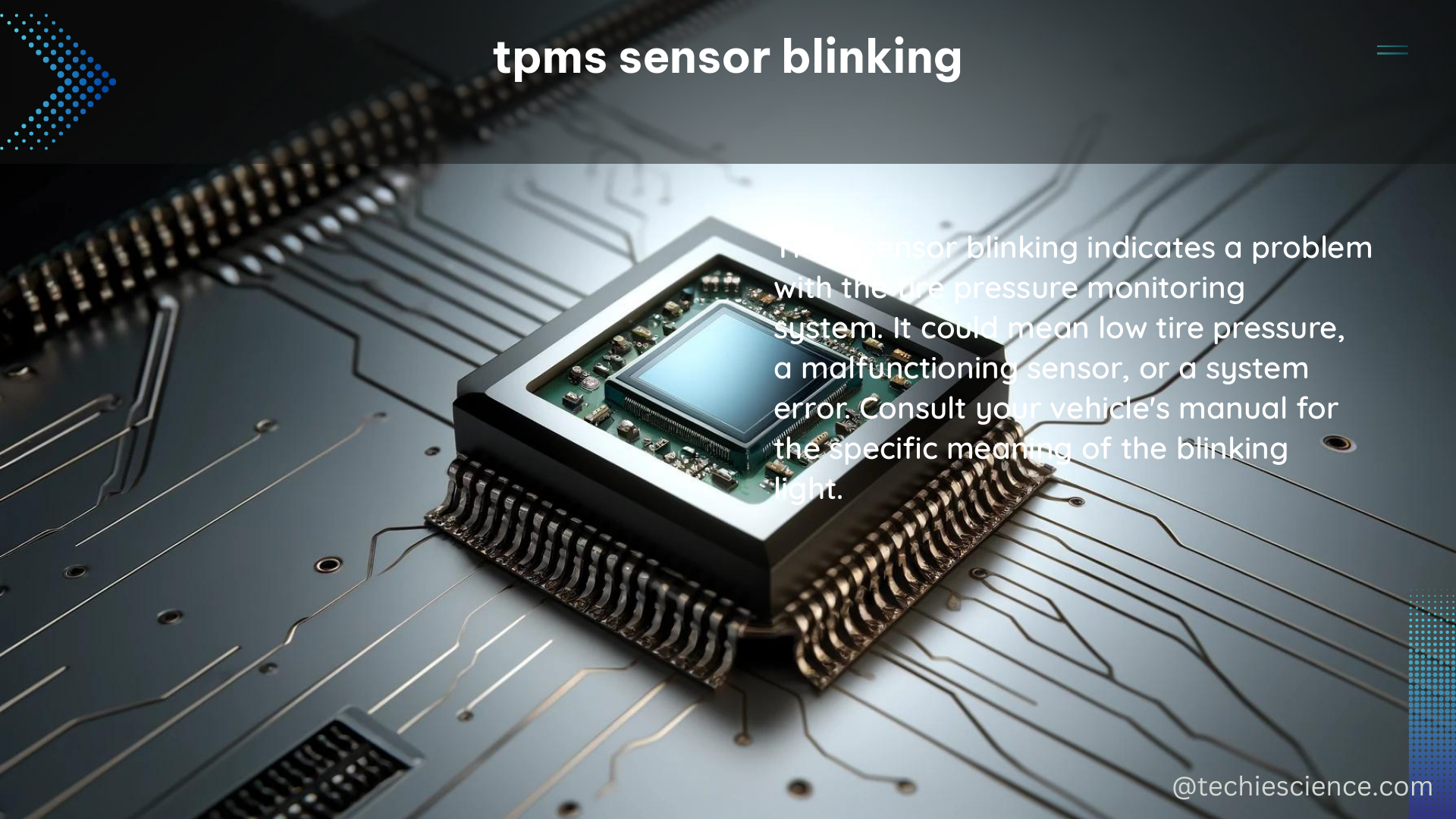The Tire Pressure Monitoring System (TPMS) is a crucial safety feature in modern vehicles, designed to alert drivers when the tire pressure in one or more tires falls below the recommended level. When a TPMS sensor starts blinking, it indicates a problem with the system that requires immediate attention. This comprehensive guide will delve into the technical details, common causes, and effective troubleshooting steps to address a blinking TPMS sensor.
TPMS Sensor Basics
TPMS sensors are small, battery-powered devices installed in each tire, typically near the valve stem. These sensors continuously monitor the tire pressure and transmit the data to the vehicle’s onboard computer. The TPMS system then displays the tire pressure information on the dashboard, alerting the driver when the pressure in any tire falls below the recommended level.
TPMS sensors are powered by lithium-ion batteries, which have an average lifespan of 7 to 9 years. The sensors are also sealed and potted, making the replacement of the battery a complex and often impractical task. Instead, it is generally more efficient to replace the entire TPMS sensor when the battery reaches the end of its life.
Causes of a Blinking TPMS Sensor

When a TPMS sensor starts blinking, it can indicate a variety of issues, including:
-
Dead Battery: The most common cause of a blinking TPMS sensor is a dead or low battery in the sensor. As the battery nears the end of its life, the sensor may start blinking to alert the driver that it needs to be replaced.
-
Incorrect Sensor Installation: If an incorrect TPMS sensor is installed in a tire, it can disrupt the communication between the sensor and the vehicle’s onboard computer, causing the sensor to blink.
-
Sensor Damage: Physical damage to the TPMS sensor, such as from a pothole or other road hazard, can also cause the sensor to malfunction and start blinking.
-
Sensor Malfunction: In some cases, the TPMS sensor itself may experience a technical malfunction, leading to the blinking warning light.
-
Tire Pressure Issues: While less common, a blinking TPMS sensor can also indicate a problem with the tire pressure, such as a slow leak or underinflation.
Troubleshooting a Blinking TPMS Sensor
When faced with a blinking TPMS sensor, it’s essential to follow a systematic troubleshooting process to identify and address the underlying issue. Here are the steps to take:
-
Check Tire Pressure: Begin by checking the tire pressure in all four tires, including the spare, and ensuring that they are inflated to the recommended pressure specified on the vehicle’s placard or in the owner’s manual.
-
Inspect the TPMS Sensors: Visually inspect each TPMS sensor for any signs of damage, such as cracks, dents, or corrosion. If a sensor appears to be damaged, it will need to be replaced.
-
Use a Scan Tool: Connect a diagnostic scan tool to the vehicle’s onboard computer to check the TPMS sensor signals. The scan tool can provide valuable information about the sensor’s status, including any error codes or communication issues.
-
Replace the Sensor(s): If the scan tool indicates a problem with one or more TPMS sensors, it’s recommended to replace all four sensors, even if only one is malfunctioning. This ensures that the entire TPMS system is functioning correctly and prevents future issues.
When replacing TPMS sensors, it’s important to use a set of five sensors (one for each tire, including the spare) that are all the same make, model, and color. This ensures compatibility and proper communication with the vehicle’s TPMS system.
- Reset the TPMS System: After replacing the TPMS sensors, the system will need to be reset to recognize the new sensors. This process varies by vehicle make and model, so refer to the owner’s manual or consult a professional for the specific steps.
Technical Specifications and DIY Tips
Technical Specifications:
– TPMS sensors use lithium-ion batteries with an average lifespan of 7 to 9 years.
– The sensors are sealed and potted, making battery replacement a complex and impractical task.
– A blinking TPMS sensor can indicate a dead battery, incorrect sensor installation, sensor damage, sensor malfunction, or tire pressure issues.
DIY Tips:
– Always check the tire pressure and ensure that all tires are inflated to the correct placard pressure.
– Use a diagnostic scan tool to check the TPMS sensor signals and identify any issues.
– When replacing TPMS sensors, use a set of five sensors (one for each tire, including the spare) that are all the same make, model, and color.
– Follow the manufacturer’s instructions for resetting the TPMS system after replacing the sensors.
Conclusion
A blinking TPMS sensor is a clear indication that there is an issue with the tire pressure monitoring system in your vehicle. By understanding the common causes and following a systematic troubleshooting process, you can effectively diagnose and address the problem, ensuring the safety and efficiency of your vehicle’s tires.
References:
- TPMS Flashing – Subaru Outback Forums
- Does anyone know why is the TPMS blinking? – r/AskMechanics
- TPMS light flashing – how do I determine which one is bad? – MyG37.com
- TPMS light blinking – ClubLexus
- Solid vs. Flashing TPMS Warning Light – Redi-Sensor

The lambdageeks.com Core SME Team is a group of experienced subject matter experts from diverse scientific and technical fields including Physics, Chemistry, Technology,Electronics & Electrical Engineering, Automotive, Mechanical Engineering. Our team collaborates to create high-quality, well-researched articles on a wide range of science and technology topics for the lambdageeks.com website.
All Our Senior SME are having more than 7 Years of experience in the respective fields . They are either Working Industry Professionals or assocaited With different Universities. Refer Our Authors Page to get to know About our Core SMEs.